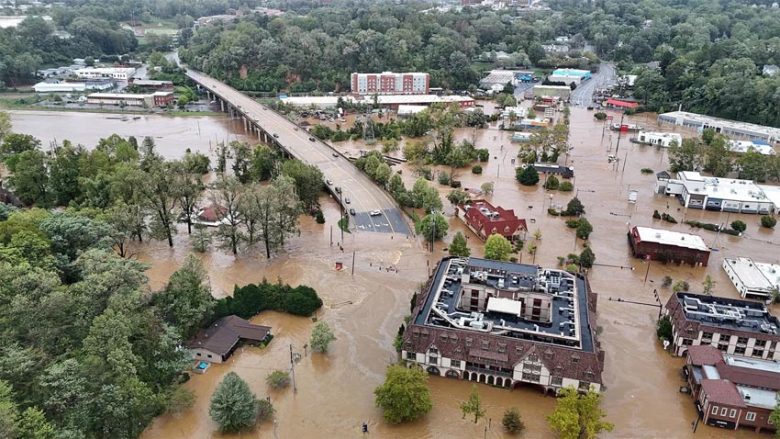Helene’s Catastrophic Damage
On September 27, 2024 Hurricane Helene caused widespread catastrophic damage and numerous fatalities in our region.

The storm triggered catastrophic rainfall and flooding in western North Carolina, East Tennessee, and southwestern Virginia.
A curfew was issued for Asheville due to storm damage. The city broke it’s record for two-day rainfall, recording 9.87 inches of rain.
Residents living downstream of Lake Lure were ordered to evacuate as its dam was overtopped by water and imminent failure was expected. The area around the dam was evaluated, and although erosion on both sides of the dam compromised the structural supports, the dam did not collapse.
After two days of rain, the French Broad River crested at 24.67 feet, and the Swannanoa River reached 26.1 feet, both higher than the all-time records set by the Flood of 1916. Almost the entirety of Biltmore Village and the River Arts District were flooded. The city became isolated due to loss of power and cell service.
Landslides around Asheville caused sections of I-26 and I-40 to collapse or wash away, forcing closures of affected routes. Travel was near impossible. The NC Department of Transportation issued a statement that all roads in western North Carolina should be considered closed.
UNCA canceled all classes through October 28. Appalachian State University cancelled classes through October 15, and Western Carolina University through October 4. Warren Wilson College and Blue Ridge Community College remained closed for at least a week.
Helene’s catastrophic flooding and destruction in western North Carolina caused at least $59.6 billion in damages and recovery needs. The storm and its aftermath caused 1,400 landslides and damaged over 160 water and sewer systems, at least 6,000 miles of roads, more than 1,000 bridges and culverts, and an estimated 126,000 homes.
On September 28, a unit from the 1st Battalion of the 169th Aviation Regiment, part of the Connecticut Army National Guard, was deployed to North Carolina to help assist disaster relief efforts. T&T Line Construction of Hornwell, New Brunswick in Canada sent 11 line crews to western North Carolina through its mutual assistance agreement with Duke Energy. Two Duke line workers hiked 1.5 miles over very rough ground to bring a power line into the Veterans’ Administration Medical Center that had gone dark due to the storm. Pack mules were utilized to access areas inaccessible by other means.
On October 2, President Biden embarked on an aerial tour of Asheville and Lake Lure. He was joined by Governor Roy Cooper and Mayor Esther Manheimer. Biden ordered the Department of Defense to deploy up to 1,000 active-duty troops to assist with aid efforts.
On October 7, the North Carolina Board of Elections passed an emergency resolution to open alternative polling sites, ease the process for requesting or replacing absentee ballots, and provide more options for voters to return their ballots.
Out of the 7 states affected, North Carolina had the highest number of fatalities—108. Due to the devastation that resulted from the storm, the name Helene was retired by the World Meteorological Organization and will never be used again for an Atlantic hurricane.








